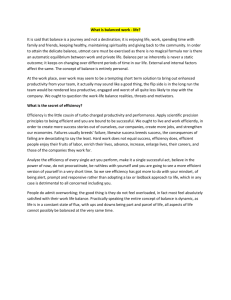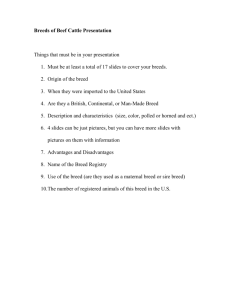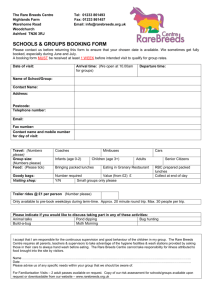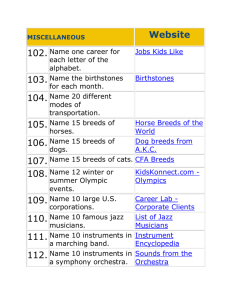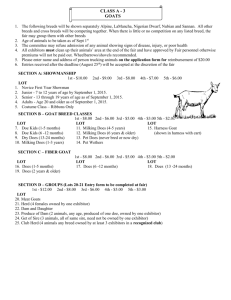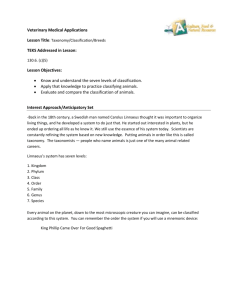Designer Dogs - Tivin Standard Poodles
advertisement
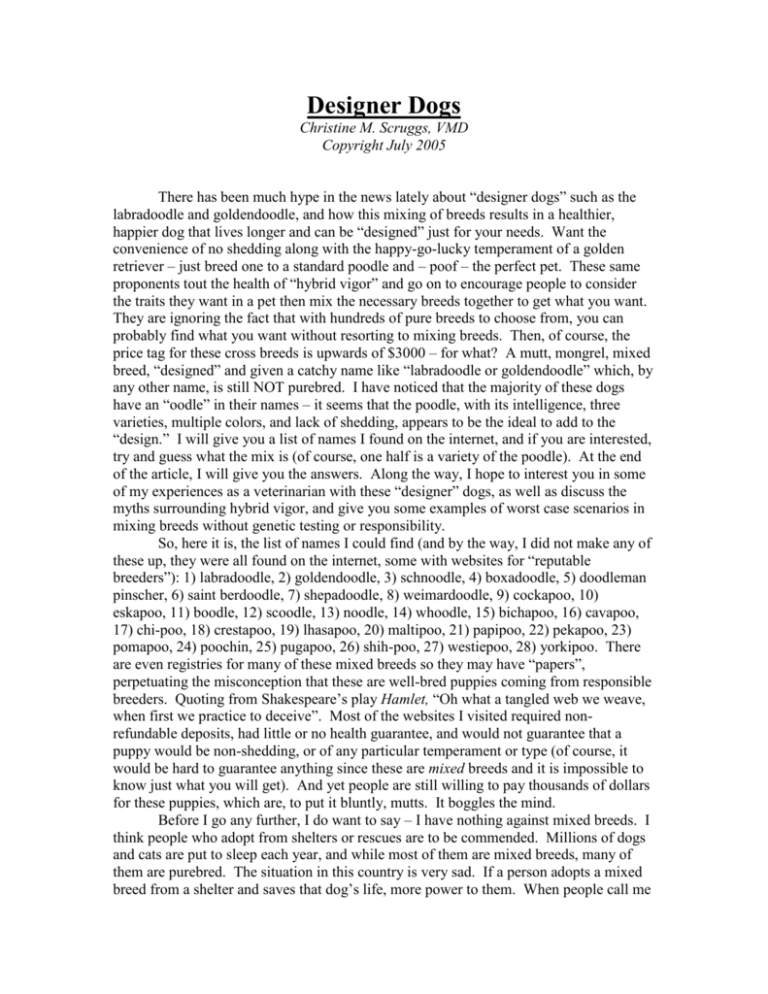
Designer Dogs Christine M. Scruggs, VMD Copyright July 2005 There has been much hype in the news lately about “designer dogs” such as the labradoodle and goldendoodle, and how this mixing of breeds results in a healthier, happier dog that lives longer and can be “designed” just for your needs. Want the convenience of no shedding along with the happy-go-lucky temperament of a golden retriever – just breed one to a standard poodle and – poof – the perfect pet. These same proponents tout the health of “hybrid vigor” and go on to encourage people to consider the traits they want in a pet then mix the necessary breeds together to get what you want. They are ignoring the fact that with hundreds of pure breeds to choose from, you can probably find what you want without resorting to mixing breeds. Then, of course, the price tag for these cross breeds is upwards of $3000 – for what? A mutt, mongrel, mixed breed, “designed” and given a catchy name like “labradoodle or goldendoodle” which, by any other name, is still NOT purebred. I have noticed that the majority of these dogs have an “oodle” in their names – it seems that the poodle, with its intelligence, three varieties, multiple colors, and lack of shedding, appears to be the ideal to add to the “design.” I will give you a list of names I found on the internet, and if you are interested, try and guess what the mix is (of course, one half is a variety of the poodle). At the end of the article, I will give you the answers. Along the way, I hope to interest you in some of my experiences as a veterinarian with these “designer” dogs, as well as discuss the myths surrounding hybrid vigor, and give you some examples of worst case scenarios in mixing breeds without genetic testing or responsibility. So, here it is, the list of names I could find (and by the way, I did not make any of these up, they were all found on the internet, some with websites for “reputable breeders”): 1) labradoodle, 2) goldendoodle, 3) schnoodle, 4) boxadoodle, 5) doodleman pinscher, 6) saint berdoodle, 7) shepadoodle, 8) weimardoodle, 9) cockapoo, 10) eskapoo, 11) boodle, 12) scoodle, 13) noodle, 14) whoodle, 15) bichapoo, 16) cavapoo, 17) chi-poo, 18) crestapoo, 19) lhasapoo, 20) maltipoo, 21) papipoo, 22) pekapoo, 23) pomapoo, 24) poochin, 25) pugapoo, 26) shih-poo, 27) westiepoo, 28) yorkipoo. There are even registries for many of these mixed breeds so they may have “papers”, perpetuating the misconception that these are well-bred puppies coming from responsible breeders. Quoting from Shakespeare’s play Hamlet, “Oh what a tangled web we weave, when first we practice to deceive”. Most of the websites I visited required nonrefundable deposits, had little or no health guarantee, and would not guarantee that a puppy would be non-shedding, or of any particular temperament or type (of course, it would be hard to guarantee anything since these are mixed breeds and it is impossible to know just what you will get). And yet people are still willing to pay thousands of dollars for these puppies, which are, to put it bluntly, mutts. It boggles the mind. Before I go any further, I do want to say – I have nothing against mixed breeds. I think people who adopt from shelters or rescues are to be commended. Millions of dogs and cats are put to sleep each year, and while most of them are mixed breeds, many of them are purebred. The situation in this country is very sad. If a person adopts a mixed breed from a shelter and saves that dog’s life, more power to them. When people call me for puppies and are unable to purchase one for whatever reason, I always recommend shelters and rescue groups. But to breed mutts deliberately, sell them for thousands of dollars, and offer little to no guarantee or support for future problems? That I find appalling. And beyond that, to use the term “hybrid vigor” as a reason to buy a mixed breed is deceptive. As a veterinarian I have seen countless mixed breeds, which, by the definition most of these “breeders” use should have “hybrid vigor” and yet they rack up hundreds to thousands of dollars in veterinary bills for skin problems, eye problems, hip/joint problems, temperament issues, heart problems, etc. So, let us discuss the term “hybrid vigor”, its definition, some examples, and how designer dogs like the labradoodle are NOT healthier due to hybrid vigor. The term hybrid vigor is perhaps most often associated with the experiments conducted by Gregor Mendel when he cross-bred various types of pea plants in order to determine inheritance patterns in genetics. He discovered that some crosses produced hardier plants such as plants which produced more fruit or lived longer or withstood infection, drought, etc. These cross-breeds were considered more “vigorous” than their parent lines, thus the term “hybrid vigor.” In some instances, the knowledge of increasing production by cross breeding different lines has been extremely beneficial in the agricultural industry. For example, in 1925, the European vineyards were struck by a severe case of “black rot,” a fungus which attacked and destroyed grape vines. Anyone who is familiar with growing grapes for wine production knows the amount of care and effort which is required to produce a great vintage (much like our famous best in show efforts). When the vintners were faced with destruction of their livelihood and legacy, they turned to cross breeding to save their precious lines. It was discovered that California grape vines were resistant to the blight which was destroying European lines. Some vintners chose to graft California strains onto their vines to save their crops. Ultimately, the cross bred vines thrived and the vineyards recovered. It is important to note in the vineyard example that there was an ultimate goal in mind when deciding to cross breed. Save the vines, produce a resistant stock, and still press superior wines. Whenever using hybrid vigor as a reason to breed, there should be a specific goal in mind. This type of cross-breeding can also be seen in the beef cattle industry. The principle of heterosis, another term for hybrid vigor, is used for meat production. By cross breeding two different breeds of cattle, for example Bos Indicus with Bos Taurus, the resultant offspring is greater than the average of its parents. A beef cow or bull produced from this cross will generally have heavier weaning weights, greater milk production, increased calf vitality, better fertility and increased resistance to disease. As the beef industry has discovered the advantages of heterosis in their livestock, breeders “purposely keep the parent breeds pure and cross-breed them to produce offspring for the meat market that grow faster and gain more weight on the same amount of food than purebred offspring from either of the parent breeds. The most dramatic results are often seen in the first generation cross.”(Lepiane, 2005) Finally, an example from the canine world can be seen in an experiment conducted with Dalmatians. As many people know, Dalmatians as a breed have a problem with producing urate stones in the bladder. Many Dalmatians never develop symptoms or have problems with the stone forming issue, but it is common enough that I see several Dalmatians with stones every year as patients. There was a study conducted several years ago to see if this problem could be cross-bred out of the Dalmatian. It was decided to breed the German shorthair pointer (because of similar genetics in spot production) and the Dalmatian. The first generation (F1) was a cross between a purebred Dalmatian and a purebred German shorthair pointer. No F1 puppies produced urate stones. The F1 generation was then back-crossed to the purebred Dalmatian line for many generations. Even several generations away from the F1 cross, with dogs which appeared in every way to be purebred Dalmatians, the problem with the urate stone production did not reappear. Again, the use of genetic principles in producing “hybrid vigor” was done so with a specific goal in mind – reduce or eliminate urate stones in Dalmatians while maintaining the phenotypic appearance of the Dalmatian line. I would argue that the goal in many breeders of poodle crosses in which they site “hybrid vigor” is really wallet vigor. In other words, they can make lots of money producing these cross breeds, without taking much responsibility. They are certainly not breeding with a specific goal in mind, other than producing cute cross breeds with catchy names like “yorkie-poo” and “noodle”. I even question some of the therapy and service dog organizations, which have tried “labradoodle” and “goldendoodle” lines, in an effort to produce a non-shedding service dog. Why not just use the poodle for heaven’s sake? The standard poodle is loyal, intelligent, highly trainable and hey, guess what, it doesn’t shed! I mention the standard as opposed to the miniature or toy, simply because most service dogs are of the size of the largest variety. I feel particularly strong about this issue because several of my puppies have gone on to become therapy dogs, and one became a hearing-ear dog, finishing the training in less time than most goldens and Labradors. She is a highly successful service dog and a blessing to her family, who had issues with allergies to service dogs of other breeds. So, do I think there is ever a reason to cross breed dogs for “hybrid vigor”? Sure, if breeders are in danger of losing their breed entirely due to loss of genetic diversity, a genetic “bottleneck” or so few reproductive individuals that inbreeding is all that is left. If this is the case, finding a closely related breed and trying to cross breed and back cross to maintain as close to the original breed as possible while introducing hybrid vigor into the genetic structure is acceptable (to me at least, although perhaps not to others). One might argue that if cross breeding is necessary than you have already lost the breed and should let it die out. Perhaps so, but consider that back-crossing as little as 5 generations consecutively will produce puppies that are only 1/32 mixed. In other words 31/32 or 97% of the genetic mix of the fifth generation back-cross will be the original breed. With the life span and reproductive nature of canines, 5 generations is a very viable alternative to letting a breed die out entirely. People are not cross breeding poodles with any of these goals in mind. I would argue that many of the crosses I mentioned in the opening of this article do not even come close to picking two closely related breeds and trying to maintain type while improving on a genetic problem. In fact, in many cases, they may be making things much worse. Imagine, for example, crossing a golden retriever with a standard poodle. What is a worst case scenario for a puppy from this cross? How about producing an arthritic, blind, shedding, dermatitis, bleeding dog that bloats? With hip dysplasia as a problem in both breeds, skin allergies a problem in golden retrievers and sebaceous adenitis in poodles, progressive retinal atrophy (pra) in the poodle and cataracts in the golden, shedding in the retriever, von Willebrand’s disease (vWD) in poodles, and both breeds bloat (also known as gastric dilatation and volvulus, where the stomach twists on itself and cardiovascular function is compromised), this could be the nightmare waiting for that unsuspecting puppy buyer. Lest you think I am being unfair to the smaller varieties of poodle, let me suggest two other crosses. What about breeding a cocker spaniel and a miniature poodle? How about producing an arthritic, blind, shedding, dermatitis, bleeding, heart disease dog with thyroid problems? With patellar luxation a problem in both breeds, cataracts in the cocker and pra in the poodle, shedding and skin problems in the cocker, allergic dermatitis, vWD, heart disease, and thyroid problems in both breeds this is another nightmare waiting to happen. Finally, what about crossing a Chinese crested and a toy poodle? How about producing an arthritic (sounds familiar doesn’t it), blind, sparse hair coat yet still sheds, dermatitis, bleeding, heart disease, toothless dog with thyroid problems that get sun-burned? Again, patellar luxation is a problem in both breeds, skin problems present in both breeds, pra in the poodle, heart disease in the poodle (I am not sure about whether there are heart problems in the crested), dental disease in both breeds, thyroid problems in the poodle and skin sensitivity in the crested. Some might argue, sure there is pra in the poodle, but if you breed it to the cocker or the crested, you would only produce a carrier of the defective gene, not an affected dog. Well, this depends on how the gene is inherited, and whether or not it is present in both breeds, among other factors. Do you honestly think most breeders who are producing these cross-breeds are spending time and money doing pedigree analysis, genetic testing, and following up on progeny reports to determine what genetic defects are being produced? I doubt it. Considering most of the websites I visited offered little to no health guarantee, and no offer of information on genetic testing, I would be skeptical that cross breeding in such a manner is producing dogs with “hybrid vigor.” Lastly, I would like to introduce two cases that I have seen as a veterinarian in practice. These are two recent cases, but each represent many such patients I have seen over the years. The first case I would like to present is a 6 month old German Shepard/Labrador retriever/Springer spaniel cross. The clients had taken a puppy from a family friend who had an “accidental” breeding between their Lab/Springer female they had adopted from the humane society and their German Shepard (GSD) male (who they thought was too young to get the female pregnant when she came into heat). They had a litter of 13, four of which died before 6 weeks of age. The remaining nine were given away, and this couple had adopted a black male who had some GSD marking around the face, a body type in between the ranginess of the GSD and the heavier bone of the Lab, and a long black haircoat, reminiscent in character (not color) of a Springer. In appearance, anyway, the puppy appeared to have characteristics from all three breeds. I had seen the puppy for his first vaccines up to four months of age and he appeared healthy. The puppy’s name was Lucky (which never bodes well) and he presented again at 6 months to be neutered. The owners also requested a hip evaluation and x-rays to be done, since they noticed that Lucky sometimes limped after exercise and he seemed reluctant to go up stairs, sometimes “hopping” up each stair. I neutered Lucky and examined his hips while he was under anesthesia. The hips easily subluxated or slipped in and out of the socket, and there was a huge amount of laxity within the joint, all completely abnormal. Hip x-rays confirmed that Lucky had severe degenerative joint disease, or hip dysplasia. Upon consultation with an orthopedic surgeon it was determined that Lucky needs complete hip replacement surgery on both hips. Because he is still a growing puppy, Lucky’s discomfort will be managed with non-steroidal anti-inflammatory medication and exercise restriction. At approximately 1 year of age he will undergo the first hip replacement surgery and then four to six months later will have the second surgery, depending upon his recovery from the first. The total bill for both surgeries, included lab work, x-rays, follow-up care, etc. will come close to $10,000. Lucky’s owners have said that he is part of their family and they will do whatever it takes to make him well, including spending such a huge amount of money. It is true that he is not a poodle cross, but despite coming from 3 breeds, he certainly does not display “hybrid vigor”. I can only wonder at the fate of his 8 surviving siblings, and whether or not any of them came down with hip dysplasia, perhaps unnoticed or untreated if their owners did not have the same resources as Lucky’s family. The second case I would like to present is a four year old Cocker Spaniel/Miniature Poodle cross (a.k.a. “cockapoo”) named “Princess.” You would not believe how many Luckys and Princesses there are as patients in a veterinary clinic. Anyway, Princess was sold with papers as a genuine, pure-bred cockapoo. When I pointed out to the owner that the term “cockapoo” is a mix of two breed names, so how could it be “purebred”, she claimed that the breeder told her the cockapoo is now a breed and even gave her papers. She brought the “papers” in for my review in a subsequent visit, and I did not recognize the registry; I am not sure if it truly exists or is a document made up by the “breeder” but I did not comment on this to Princess’s owner. In any case, like Lucky’s owner, Princess’s owner wanted to best for her “baby.” Princess suffers from recurrent skin and ear infections as well as being an epileptic. She had her first seizure around two years of age and is mostly seizure-free on phenobarbitol. I recommended submitting a culture and sensitivity of Princess’s ears, and placed her on a two week course of strong, broad-spectrum antibiotics while awaiting the results. I also prescribed prednisone for pain and inflammation as her ears and her skin were extremely infected and irritated. An allergen-free diet had already been tried, with no success, so I suggested testing Princess’s thyroid function and/or allergy testing if necessary. The owner has a limited income and was unable to pay for any extensive testing. I had also recommended considering a consultation with a dermatologist, but again, finances limited options. The culture and sensitivity from Princess’s ears grew a highly resistant pseudomas infection. The antibiotics I originally prescribed were effective, so the prescription was extended for a total of four weeks. While Princess’s ear and skin infections healed, her ear canals were extremely stenotic, or closed down, from chronic inflammation. It would most likely be beneficial for her to have bilateral surgery on both ears to open up the ear canals, but her owner cannot afford such surgery. Along with treating her epilepsy and skin and ear problems, Princess’s owner could not afford pursuing more extensive avenues of treatment. Here is a case where the owner not only has a “hybrid” dog without the “vigor” she also has “papers” and believes her dog to be purebred! To quote once more from Shakespeare, “The common curse of mankind, folly and ignorance" (Troilus and Cressida). I believe the myth of hybrid vigor in the examples of the multitudes of poodle crosses has been thoroughly disproved. The so-called “breeders” who are touting healthier dogs by creating mixed breeds in the manner which most of these puppies are conceived are often deceptive and ignorant. Most of these “breeders” do not offer any health guarantee, genetic testing, genetic analysis, or any other support to the puppy buyers. Earlier in this article I listed 28 crosses I found on internet websites. Here are the answers to the breeds which were crossed with a poodle to create the “hybrid”: 1) Labrador retriever, 2) golden retriever, 3) schnauzer, 4) boxer, 5) Doberman pinscher, 6) Saint Bernard, 7) German shepherd, 8) weimeraner, 9) cocker spaniel, 10) American Eskimo, 11) bulldog, 12) Scottish terrier, 13) Norwich or Norfolk terrier, 14) Wheaton terrier, 15) bichon frise, 16) cavalier king Charles spaniel, 17) Chihuahua, 18) Chinese crested, 19) Lhasa apso, 20) maltese, 21) papillon, 22) Pekinese, 23) Pomeranian, 24) Japanese chin, 25) pug, 26) shih tsu, 27) west highland white terrier, 28) Yorkshire terrier. I also came across several “Daisy” dog websites – a triple cross containing the poodle, bichon and shih-tsu. As I have said previously, it boggles the mind. Perhaps these people should concentrate on one breed, and the betterment of that breed, than creating more problems while hiding behind the term “hybrid vigor.” It is scary to think that our poodles are so popular for cross breeding. Perhaps with education and understanding, and very careful selection of our puppy buyers, we can prevent the continued misinformation and poor breeding practices which are occurring. Designer dogs, it appears, are often designed disasters.
